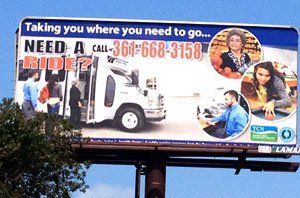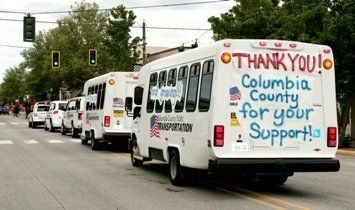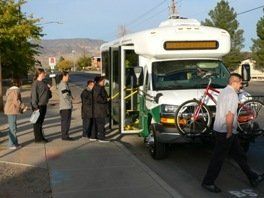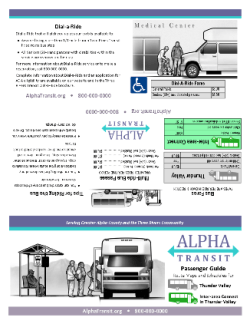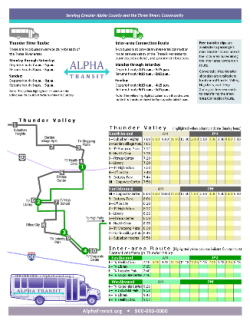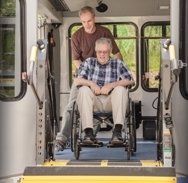Marketing Transit Toolkit
RESOURCES > TOOLKITS
Table of Contents
- Welcome
- How-to Guide For Marketing Transit
- Marketing Overview
- Marketing in the Transit Environment
- Developing a Marketing Plan
- Strategies for Marketing Public Transit
- Fundamental Communications
- Strategies for Building Awareness, Image, and Support
- Targeted Strategies for Generating Ridership
- Marketing Plan Workbook
- Marketing Tools
- Photo Library
- Graphics Library
- Templates
- Transit Benefits Statistics
- Other Tools
- Other Resources
Marketing Toolkit Overview
This toolkit is designed as a comprehensive and practical guide for rural and tribal public transportation agencies to develop and implement successful marketing programs for their systems. Transit agencies in smaller communities rely on a relatively small staff to keep the wheels turning. Of necessity, transit managers are involved in virtually all aspects of their organization, supervising day-to-day operations, vehicle maintenance, customer service, financial reporting and more. Some even drive the buses.
The goal of this toolkit is to help transit managers when they need to step into the marketing role by supplying them with the information and tools they need in a straightforward way.
Note: National RTAP has recently hosted multiple marketing webinars, listed below. These provide a comprehensive guide to marketing public transit. The 101 webinar would be best if you have limited time. If you want more in-depth information on a particular topic, or all topics, the Marketing Workshop Series is a great resource. You can view the recordings and slides via the links below.
- Transit Marketing 101 | 8/27/21 | Webinar | Presentation
- Marketing Workshop #1: Build Awareness | 1/13/22 | Webinar | Presentation
- Marketing Workshop #2: Transit Websites | 2/10/22 | Webinar | Presentation
- Marketing Workshop #3: Passenger Information | 3/10/22 | Webinar | Presentation
- Marketing Workshop #4: Community Based Marketing | 4/5/22 | Webinar | Presentation
- Marketing Workshop #5: Transit Market Research - Understanding Our Riders | 5/24/22 | Webinar | Presentation
- Marketing Workshop #6: Improving the Transit Passenger Experience
| 6/28/22
|
Webinar |
Presentation
- Tools for Marketing & Trip Planning: Website Builder & GTFS Builder | 4/20/22 | Webinar | Presentation
How-To Guide
The first section of the toolkit is a guide for marketing transit and provides directions for identifying and accomplishing marketing goals and objectives.
The How-To Guide begins with an overview of marketing in general, then takes a closer look at marketing’s role in the transit environment. Transit marketing must pursue a variety of objectives and address diverse target markets. It also needs to be ongoing — a part of the day-to-day operation of the service.
There are many reasons that a transit system should implement an active marketing effort. These include:
- Raise awareness of public transit in the community
- Dispel misconceptions
- Increase ridership
- Influence the community to support public transit
- Satisfy funding requirements
Once a system decides to market, it must determine who it wants to communicate with and what messages need to be conveyed in order to accomplish the system’s objectives. Target markets for transit marketing include current riders, potential riders, and non-riders (such as local decision makers) who are important supporters of the system.
In communicating with these groups, it is important to speak in terms of the benefits of transit that are relevant to them. Riders and potential riders will be most influenced by the personal benefits of transit, such as mobility, affordability, and convenience. Decision makers and stakeholders will be more interested in the economic and societal benefits for the community as a whole.
Developing a Marketing Plan
This page focuses on developing a practical marketing plan. Like a good road map, a plan will show you the way from where you are now to where you want to be, pointing out different options along the way.
This page explains each step in the process of developing a marketing plan and is accompanied by the following Marketing Plan Worksheets to help you in creating your own plan.
- Assessing Your Situation
- Counting Your Resources
- Goals and Objectives
- Target Markets
- Selecting Marketing Strategies
Marketing Strategies
Strategies used to market public transit are as numerous and varied as the target groups that you want to reach. This final section of the How-To Guide includes a menu of potential marketing strategies. It is not necessary to use all of them. Some are essential for effective marketing, others are important once the essential items are in place, and others are optional, to be selected based on your needs and resources.
Each strategy has been assigned a priority to help you decide which ones to consider —
1. Fundamental, 2. Recommended, 3. Optional.
The strategy menu includes:
- Fundamental Communications — Branding and Passenger Information
- Strategies for Building Awareness, Image, and Support
- Strategies for Generating Ridership
Examples are presented throughout the text to illuminate principles being discussed and to suggest solutions to specific issues that may affect your system.
Links throughout the strategy section will take you to the marketing tools included in this toolkit that you can customize for your system and use right away. These tools make up the second and third sections of the toolkit, Templates for Marketing Materials and Photo and Graphics Libraries.
Templates for Marketing Materials
This section consists of marketing tools that can be used to implement the strategies outlined in the How-To Guide. The following templates, guidelines, and other tools are included:
Brochure/Passenger Guides
Letter-Sized
With map and schedule
Without map and schedule (for Dial-a-Ride)
Legal-Sized (with map)
Tabloid-Sized (for multiple route systems)
Bus Stop Signs
Stationery
Business Card
Letterhead
Printed Promotional Materials
Letter-Sized Flyer
Tabloid-Sized Poster
Newspaper Ad
Postcard for Direct Mail
Newsletter – print
Newsletter – email
Other Promotional Tools
PowerPoint Presentation
Radio Script Guidelines
News Release Guidelines
Utilities
Map-Maker Template
Schedule Maker Template
Customizing Templates in Microsoft Publisher
Printing Instructions
Letter-sized 3-panel brochure/passenger guide template using a horizontal format.
All of the templates for print materials are designed in Microsoft Publisher and are provided with detailed instructions for adapting them to your individual transit system.
Transit Benefits Statistics
We've compiled a list of compelling statistics from diverse national sources that your organization can add to presentations, brochures, handouts, and advertisements to help demonstrate the many benefits and lasting value of public transit. By using powerful data in your marketing materials, you can influence stakeholders to foster policies and improve funding mechanisms that invest in and expand the reach of transit. Statistics in this toolkit can also be used in direct consumer marketing materials to attract and retain current and future riders.
Photo and Graphics Libraries
The toolkit also includes two libraries of copyright-free visuals, which you can use along with the templates to create marketing materials for your agency. Included in the libraries are instructions for editing and placing the visuals in your templates.
Photo Library
The photo library is a collection of photographs that feature a diversity of people who use transit and illustrate how they use the system. These images include:
- People who represent various target groups, such as students, workers, seniors and persons with disabilities;
- Transit-related activities, such as riders reading or using mobile devices on the bus;
- Interactions, such as drivers assisting riders as they board or exit the bus using the wheelchair lift;
- Interior shots of a variety of people seated on the bus.
In addition are images of buses in rural landscapes.
Any of these photos that are appropriate for your system can be used as-is. However, you also are encouraged to use these as references for taking your own pictures. Included in the toolkit is a collection of useful tips for doing just that, as well as a photo release form that the people you want to photograph will need to sign. (See Marketing Tools > Other Tools)
Graphics Library
The graphics library consists of line-art images that can be used in color or black and white. These include:
- Simple graphics depicting public transit vehicles — buses, cutaways and vans — side and front views
- Fully rendered illustrations of public transit vehicles — buses, cutaways and vans — side and front views
- Fully rendered illustrations of public transit vehicles — buses, cutaways and vans — with passengers, in varying situations:
- At bus bench/shelter
- At the market
- At a medical center
- With a small-town background
- With a desert background
- With mountains in background
- With pines in background
- Icons and Symbols, including Universal Bus, Wheelchair Accessibility, No Parking, Bicycle, and Social Media.
Put this Toolkit to Work for Your System
As a transit manager, you can cite many reasons for marketing your system — ridership could use a boost, people in the community don’t have a clear picture of what your system has to offer, your grant funding requires that you ”market“ your services. Marketing offers solutions to many of the challenges that public transit agencies face, and it is capable of putting a new face on your system.
The information, design elements, instructions, and examples provided here will help you put marketing to work for you.
Don't see what you're looking for?

National RTAP offers one-stop shopping for rural and tribal transit technical assistance products and services. Call, email, or chat with us and if we can’t help with your request, we’ll connect you with someone who can!
" National RTAP offers one-stop shopping for rural and tribal transit technical assistance products and services. Call, email, or chat with us and if we can’t help with your request, we’ll connect you with someone who can! "
Robin Phillips, Executive Director
" You go above and beyond and I wanted to let you know that I appreciate it so much and always enjoy my time with you. The presentations give me so much to bring back to my agency and my subrecipients. "
Amy Rast, Public Transit Coordinator Vermont Agency of Transportation (VTrans)
" I always used the CASE (Copy And Steal Everything) method to develop training materials until I discovered RTAP. They give it to you for free. Use it! "
John Filippone, former National RTAP Review Board Chair
" National RTAP provides an essential service to rural and small transit agencies. The products are provided at no cost and help agencies maximize their resources and ensure that their employees are trained in all aspects of passenger service. "
Dan Harrigan, Former National RTAP Review Board Chair
" We were able to deploy online trip planning for Glasgow Transit in less than
90 days using GTFS Builder. Trip planning information displays in a riders'
native language, which supports gencies in travel training and meeting Title VI
mandates. "
Tyler Graham, Regional Transportation Planner Barren River Area Development District
Slide title
" Having a tool like GTFS Builder is really light years ahead of what it used to be at one time in terms of how fast you can put everything together. Our university students really can't imagine transit without it, so I think it's very important for us in terms of attracting that particular demographic. "
Michael Lachman, Transportation Services Manager HAPCAP - Athens Transit
Slide title
" In the past we used proprietary database software that was very challenging, very murky, and hard to update. GTFS Builder is a great opportunity to make this more user-friendly, more readily updatable and it
would enable us to show how to create a GTFS to more of the staff. "
Jaime McKay, Former Manager of Direct Services Center for Mobility Equity
Slide title
" Collaboration is a buzz word these days in the industry. On behalf of our Tribal segment, I appreciate RTAP for making Tribes a partner in industry opportunities. The organization goes over and beyond reaching partners one would not expect in a busy industry such as public transportation. Thank you for your tireless efforts! "
Franklin Akoneto, Comanche Nation
Slide title
"We are so very thankful for all your transportation training materials. Your resources are as valuable as gold!"
Holly Walton, Transportation Assistant Manager, Curative Connections
A program of the Federal Transit Administration administered by the Neponset Valley TMA
National RTAP is committed to making this website accessible to persons with disabilities. If you need assistance accessing any content on our website or need alternative formats for our materials, please contact us at info@nationalrtap.org or 781-404-5020.
by National RTAP |

